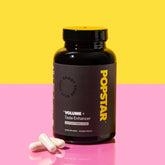

Table of contents
Key Takeaways
Learning what turns you on helps you finish faster.
A relaxed, present mindset can speed things up.
The right rhythm, pressure, and lube make a big difference.
Talking openly with your partner reduces pressure and boosts connection.
If it’s a regular issue, a doctor can help identify the cause.
In the realm of intimacy, everyone's journey is unique, and concerns about timing—whether taking too long or too short—are common. Questions about how to orgasm faster often arise for various reasons. Some may wish to align with a partner's preferences, navigate time constraints, or address challenges like delayed ejaculation. This thoughtful guide will explore healthy, practical, and respectful ways to approach this topic while emphasizing open communication, emotional intimacy, and overall sexual well-being.
How to Orgasm Faster
1. Understand Your Body
The first step to addressing any concerns is understanding your body's responses. Masturbation can be a valuable tool for self-exploration, helping you identify what stimulates you most effectively. Pay attention to the techniques, pressure, and thoughts that bring you closer to cum. Incorporating methods like kegel exercises for men may also help improve your control over timing and enhance sexual satisfaction.
2. Explore Psychological Factors
Psychological factors like sexual performance anxiety, stress, or overthinking can sometimes delay climax. Techniques such as mindfulness exercises and relaxation methods can help address these barriers. Here are some approaches to try:
Practice mindfulness techniques or meditation before intimacy.
Focus on the present moment rather than the outcome.
Address performance pressure by fostering a positive mindset, making it easier to relax and cum more naturally.
3. Experiment with Stimulation
Different techniques can speed up the process of reaching climax. These may include:
Increasing arousal through enhanced stimulation methods to help you cum faster.
Focusing on your erogenous zones , which are highly sensitive to touch and can heighten arousal.
Adjusting rhythm and pace to discover what works best for you, allowing you to control how quickly you cum.
Incorporating these techniques can enhance your sexual satisfaction while maintaining a pleasurable experience for both partners.
4. Use Visual or Mental Aids
For some individuals, sexual arousal can be enhanced through visual or mental stimulation, such as erotic imagery or fantasies. Discuss with your partner what excites you most and explore ways to integrate these preferences into your intimate moments. Such honest conversations are key to fostering open communication in relationships , which can help reduce anxiety and make it easier to cum during intimacy.
5. Explore Medical or Physiological Causes
Persistent concerns with delayed ejaculation or difficulty to cum could be linked to medical factors, such as medication side effects or underlying health conditions. Consult a sexual health professional for tailored guidance. Addressing potential physiological causes ensures your approach is both informed and effective.
6. Open Communication with Your Partner
A successful intimate relationship thrives on emotional intimacy and open communication . Talk openly with your partner about your needs and concerns. When both partners feel supported and valued, it reduces pressure, making it easier to cum naturally and enjoy the experience fully.
7. Consider Timing Tools
Certain strategies and tools, like climax control techniques or specialized sexual aids, may help you manage timing more effectively. Additionally, exercises like kegel exercises for men can strengthen pelvic muscles, offering better control during intimacy and making it easier to cum when desired. Speak with a specialist to determine what might work best for your goals.
Final Thoughts
Intimacy is a shared experience, not a race. While exploring ways to cum faster, prioritize connection, trust, and understanding. Remember, achieving balance in your timing concerns requires patience and kindness—both for yourself and your partner. With these strategies, you'll not only address challenges but also foster greater sexual well-being and satisfaction in your relationship.
Frequently Asked Questions
Is it normal to wonder how to cum faster?
Yes. People ask this because sex sometimes runs long, arousal dips, a partner gets sore or tired, or you’re dealing with delayed orgasm from stress, medications, or overthinking. Wanting to climax sooner doesn’t mean anything is “wrong” — it just means you’d like a more predictable finish.
What’s the fastest way to cum (in one sentence)?
Maximize arousal and sensation while minimizing friction losses: use plenty of lube, targeted stimulation (for example clitoral or frenular focus), a rhythm you can maintain, turn-ons that actually work for you, and a calm, pressure-free headspace.
What does “cum faster” actually mean?
It usually means reducing time-to-orgasm from your personal baseline. That could be shaving a few minutes off, or going from “can’t finish” to finishing reliably within a session. The goal is comfort, consent, and satisfaction — not a stopwatch.
How long does it “normally” take to cum?
There’s a wide range. For penis-owners during partnered penetration, many people ejaculate within several minutes once highly aroused. For vulva-owners, clitoral-focused stimulation often leads to orgasm faster than penetration alone. “Normal” spans from under a minute to 30+ minutes depending on context, stimulation type, and headspace.
What are the biggest blockers when you want to cum faster?
Performance pressure and anxiety
Insufficient direct stimulation (clitoral, frenulum, or favorite spots)
Low arousal (rushed foreplay, distractions, stress)
Dryness or too much friction (not enough lube)
Side effects of meds, alcohol, or substances
Fatigue, pain, or medical issues (pelvic pain, prostatitis, hormonal shifts)
How does mindset affect how fast you cum?
A lot. Anxiety pushes your body into “threat mode,” making climax harder. Erotic focus (“this feels good right now”) helps your brain’s reward pathways flip from vigilant to sensual.
Practical mental techniques to cum faster?
Reduce pressure: agree with your partner that orgasm is welcome but not required. Less pressure makes it easier.
Narrow your focus: pay attention to the single best sensation rather than scanning everything.
Use fantasy or erotic cues: dirty talk, a favorite mental scenario, or porn you actually like (in moderation) can accelerate arousal.
Breath work: steady, deep breathing keeps you in a relaxed arousal zone. Shallow, anxious breathing stalls orgasm.
Can music, lighting, or environment help me finish faster?
Yes. Warm lighting, privacy, a comfortable temperature, and a curated playlist can reduce distractions, increase safety cues, and let your body “let go” sooner.
What kinds of stimulation usually make people cum faster?
For vulva-owners: consistent, rhythmic clitoral stimulation (fingers or a small vibrator) plus lube often outpaces penetration alone.
For penis-owners: focused frenular/underside stimulation, snug hand technique with lube, or a vibrator on the frenulum or perineum often shortens time.
For all: relentless consistency — same angle, pressure, rhythm — until the “lift-off” feeling builds.
Best positions to cum faster?
Vulva-owners: positions that press the clitoris against pubic bone or allow direct clitoral access (missionary with pelvic tilt, cowgirl with grinding, side-lying with hand-on-clit).
Penis-owners: positions that maximize friction/pressure at the underside of the glans and let you control pace (missionary with shallow thrusts, prone thrusting, or partner-on-top with your hand involved).
Does lubrication make you cum faster?
Often yes. Lube reduces irritating friction and lets you keep a quick, steady rhythm. Choose water- or silicone-based lube (silicone lasts longer; water-based cleans easier). Reapply freely.
What about changing thrust depth?
Shallower, rhythmically consistent strokes can preserve endurance while concentrating sensation on the most responsive areas. Many people cum faster from a steady tempo than from frequent depth/angle changes.
Vibrators and toys — do they speed things up?
Usually.
Clitoral vibrators: small, precise, and powerful — great for fast orgasms.
Wands: strong rumble; can work over underwear or on the perineum for penis-owners.
Strokers/sleeves: snug, textured stimulation can shorten time for penis-owners.
Couples rings: add clitoral contact during penetration.
Experiment to find intensity and pattern you can ride to climax without numbing out.
Is edging helpful if I want to cum faster?
Counterintuitive but yes — for some. Regular edging practice teaches awareness of your arousal curve. Over time, you recognize the “point of inevitability” and can reach it more directly during partnered sex. But during a session where you want to finish quickly, skip prolonged stops and focus on steady escalation.
Does porn help or hurt?
Depends. Porn that matches your real turn-ons can speed things up. But high-novelty or rapid-scroll porn can condition your brain to need constant newness, slowing real-life orgasm. Use intentionally: favorite clip, no endless searching, then focus on your partner or your body.
Are there fast hand techniques for penis-owners?
Use warm lube.
Grip just tight enough to feel snug at the coronal ridge.
Focus strokes on the underside/frenulum; add circular motions under the head.
Keep a consistent fast-but-sustainable rhythm for 60–120 seconds; avoid stopping unless you’re about to finish and want to coordinate with a partner.
Fast techniques for vulva-owners?
Apply lube and choose a consistent motion (up-down or circular) on the clitoral glans or hood edge — whichever feels best.
Combine with pelvic rocking against a firm surface or partner’s pubic bone.
Keep pressure steady; change only one variable at a time (speed, angle, or pressure) to hone in quickly on the “right” pattern.
Can longer foreplay make me cum faster once we start “the main event”?
Usually yes. Think of foreplay as “preheating.” When you reach high arousal before penetration or targeted stimulation, orgasm typically comes sooner.
What sensory add-ons help?
Gentle pressure on nipples, neck, inner thighs.
Temperature play (warm breath, cool fingertips).
Lube-safe arousal gels that create warmth/tingle (test on a small spot first).
Kegel squeezes during stimulation.
Will Kegels help me cum faster?
They can. A responsive pelvic floor amplifies orgasmic contractions.
How: Perform 3 sets of 10 gentle squeezes daily (exhale as you squeeze; fully relax between reps).
During sex: Try light rhythmic squeezes as you approach peak; many people feel a stronger, faster build.
Breathing patterns for faster climax?
Yes. Keep exhales slightly longer than inhales to maintain relaxation (inhale 4, exhale 6). As you near orgasm, let breath get a bit quicker and fuller — don’t hold it.
Does fitness matter?
General cardio and core endurance help you maintain steady positions and rhythm, reducing fatigue-related stalls. You don’t need a six-pack; you need comfort and stamina in the positions you enjoy.
What should I tell my partner if I want to cum faster?
Be specific and positive: “I cum fastest when you keep that exact pressure on my clit,” or “Can I use my hand/vibrator while we’re in this position?” Partners appreciate clear guidance more than guessing.
How do we stay connected if I need focused, repetitive stimulation?
Maintain eye contact, exchange a few words, sync breathing, or add a free hand for caressing elsewhere. Connection and repetition can coexist.
Is it okay to finish with my own hand or a toy during partnered sex?
Absolutely — with consent. Many couples make this their default when time is short.
What’s the “express lane” to cum faster solo?
Privacy, lube, your best toy or technique, a reliable erotic cue (memory, audio, brief clip), and zero multitasking. Consistency beats intensity.
The “express lane” with a partner?
Start with what you know works fastest (clitoral vibrator or frenulum focus) before penetration. If penetration is important, keep the toy in place during intercourse and pick a position that keeps it anchored.
Which medications might slow climax — so I know what to discuss with a clinician?
Common culprits include certain antidepressants (especially SSRIs/SNRIs), antipsychotics, some blood pressure meds, finasteride/dutasteride, and opioids. Do not stop or change prescriptions on your own; talk to your prescriber about options (dose timing, formulation changes, or alternative meds).
Does alcohol make it harder or easier to cum?
Alcohol often impairs arousal and orgasm, especially at higher amounts. If you’re trying to cum faster, minimal alcohol is usually better.
Can cannabis or other substances help?
Responses vary widely; for many, they dull sensation or focus, lengthening time to climax. If you experiment, do it safely and note your personal effect.
Could hormones be involved?
Yes. Lower testosterone in penis-owners or hormonal shifts across the cycle or with menopause in vulva-owners can change arousal patterns. If you notice persistent changes, a clinician can evaluate.
What about pain or medical issues?
Pain, pelvic floor dysfunction, prostatitis, endometriosis, and other conditions can interfere with arousal and orgasm. Treating the underlying condition often shortens time to climax because comfort returns.
Are there products specifically for cumming faster?
There aren’t “faster” pills with strong evidence; most topical products focus on delaying ejaculation (desensitizers). For speed, the best-supported tools are lubricants and vibrators (clitoral, wand, bullet, or frenulum/perineum use) and well-designed strokers for penis-owners.
Any risk with strong vibrators if I use them to finish fast?
Temporary numbness can occur if intensity is too high or duration too long. To stay sensitive, use the lowest effective setting, take short breaks if needed, and vary direct vs. indirect contact (for example through fabric).
Can condoms change how fast I cum?
Yes. Thinner condoms may lead to faster ejaculation for some; thicker or textured condoms may slow things down. Balance sensation with safer-sex needs. If latex is uncomfortable, try polyurethane or polyisoprene.
Best lubes for finishing faster?
Water-based: versatile, toy-safe, easy cleanup; may need re-application.
Silicone-based: very slick and longer-lasting; great for water play; avoid with silicone toys unless the label says compatible.
Hybrid: water + silicone for balanced glide.
Fast-finish routine for vulva-owners (solo or partnered)
Privacy, warm environment, favorite erotic cue ready.
Apply lube to clitoral area.
Choose the most reliable motion (small circles or up-down strokes) and stick to it.
Keep pressure steady; increase speed slightly every 10–20 seconds as arousal builds.
Add pelvic floor pulses (light squeezes) during the last 30–60 seconds.
If partnered, keep the same hand/vibe position during penetration; avoid stopping to reposition unless absolutely necessary.
Fast-finish routine for penis-owners (solo or partnered)
Warm lube; grip snugly just below the head.
Focus strokes along the underside/frenulum, adding brief twists over the coronal ridge.
Maintain a quick, consistent tempo you can hold.
Add a small vibrator to the frenulum/perineum if you want extra speed.
As you approach climax, keep breathing steady and avoid sudden stops.
Partnered “on-ramp” that shortens time for both
Start with 3–5 minutes of the most potent direct stimulation (hand/vibe/oral focused exactly where it counts).
Transition to your preferred position without removing the stimulus.
Keep the rhythm identical until climax — no flashy mid-sequence changes.
I get in my head and can’t finish. How do I get out of that loop faster?
Agree that orgasm isn’t required (pressure reduction).
Choose one focus point (the exact sensation you want).
Use a mental anchor (“right there, don’t change anything”).
If thoughts wander, gently escort your attention back to that anchor.
If anxiety persists session after session, consider sex-positive counseling; a few sessions can transform outcomes.
Does mindfulness really help with orgasm speed?
Yes. Mindfulness trains attention and reduces intrusive thoughts. Even 5 minutes a day of breath-anchored practice can make a difference in sexual focus.
Can scheduling sex help me cum faster?
Counterintuitive, but yes — if you pick times you’re naturally energetic, not stressed or exhausted. Your body finishes faster when it isn’t fighting fatigue.
What if my partner wants me to finish quickly but I don’t?
Discuss boundaries and preferences. You can create two play “modes”: an “express” mode for when time is short and a “leisure” mode for exploring and taking your time. Consent and mutual comfort come first.
Is it okay to stop before climax?
Absolutely. Pressure to finish can sabotage arousal. Stopping or switching to non-goal-oriented touch keeps sex positive and can make next time easier and faster.
I used to finish fast; now it takes forever. What changed?
Common reasons: new meds, higher stress, less sleep, less foreplay, more alcohol, different porn habits, relationship tension, or medical issues. Scan these factors and adjust one or two at a time.
It takes me a long time with a condom — any tips to cum faster while staying safer?
Try a thinner condom, add extra lube inside (just a drop or two) and outside, use a snugger fit if slippage reduces sensation, and integrate manual or vibrator stimulation during intercourse.
I’m on an SSRI and can’t finish — now what?
Talk to your prescriber about options: dose adjustments, timing (for example taking the dose after sex), switching agents, or augmentation strategies. Do not make changes on your own.
I numb out with a high-power vibrator and then it takes longer — fixes?
Lower intensity, shorter bursts, use it through fabric or over the hood, and switch to a rumbly (low-frequency) device rather than a buzzy one.
Pain slows me down — how can I still cum faster?
First, address pain (position changes, more lube, slower entry, medical evaluation if persistent). When pain reduces, arousal rises more quickly and orgasm follows.
Can porn-free periods reset my speed?
For some people, yes. A week or two focusing on body sensations and imagination can re-sensitize you to real-life stimulation and shorten time to climax.
Does hydration or nutrition matter?
Indirectly. Dehydration, heavy meals, or alcohol can reduce energy or sensation. Light meals, hydration, and feeling physically good make faster orgasms more likely.
Can pelvic floor over-tightness slow orgasm?
Yes — some people hold chronic tension. If Kegels make things worse, try pelvic floor relaxation (deep diaphragmatic breathing, gentle stretches) or consult a pelvic floor physical therapist.
Is faster always better?
No. The “best” pace is the one that feels good to you and your partner. Sometimes the goal is fast; sometimes it’s slow and connected. Having both options is sexual skill.
Any red flags that mean “see a clinician”?
Sudden, persistent inability to climax despite working strategies
New pain, numbness, or loss of sensation
Major mood changes, medication side effects, or pelvic symptoms
Concerns about hormones or chronic conditions
Quick-start plan to cum faster tonight
Pick your moment: Choose a low-stress time.
Set the scene: Warm lighting, privacy, comfortable temperature, music.
Agree on the plan: “Let’s go with what gets me off fastest — no pressure if it doesn’t happen.”
Prime arousal: 3–5 minutes of your most reliable foreplay (clitoral or frenulum focus).
Add lube: Generously. Reapply without hesitation.
Choose the fastest tool: Your best vibrator or hand technique.
Lock the rhythm: Find the “right” pressure/angle and keep it consistent.
Focus your mind: One sensation, one fantasy. Breathe steadily.
Use the squeeze: Gentle pelvic floor pulses as you near climax.
Finish and aftercare: Hydrate, cuddle, celebrate, and note what worked for next time.











